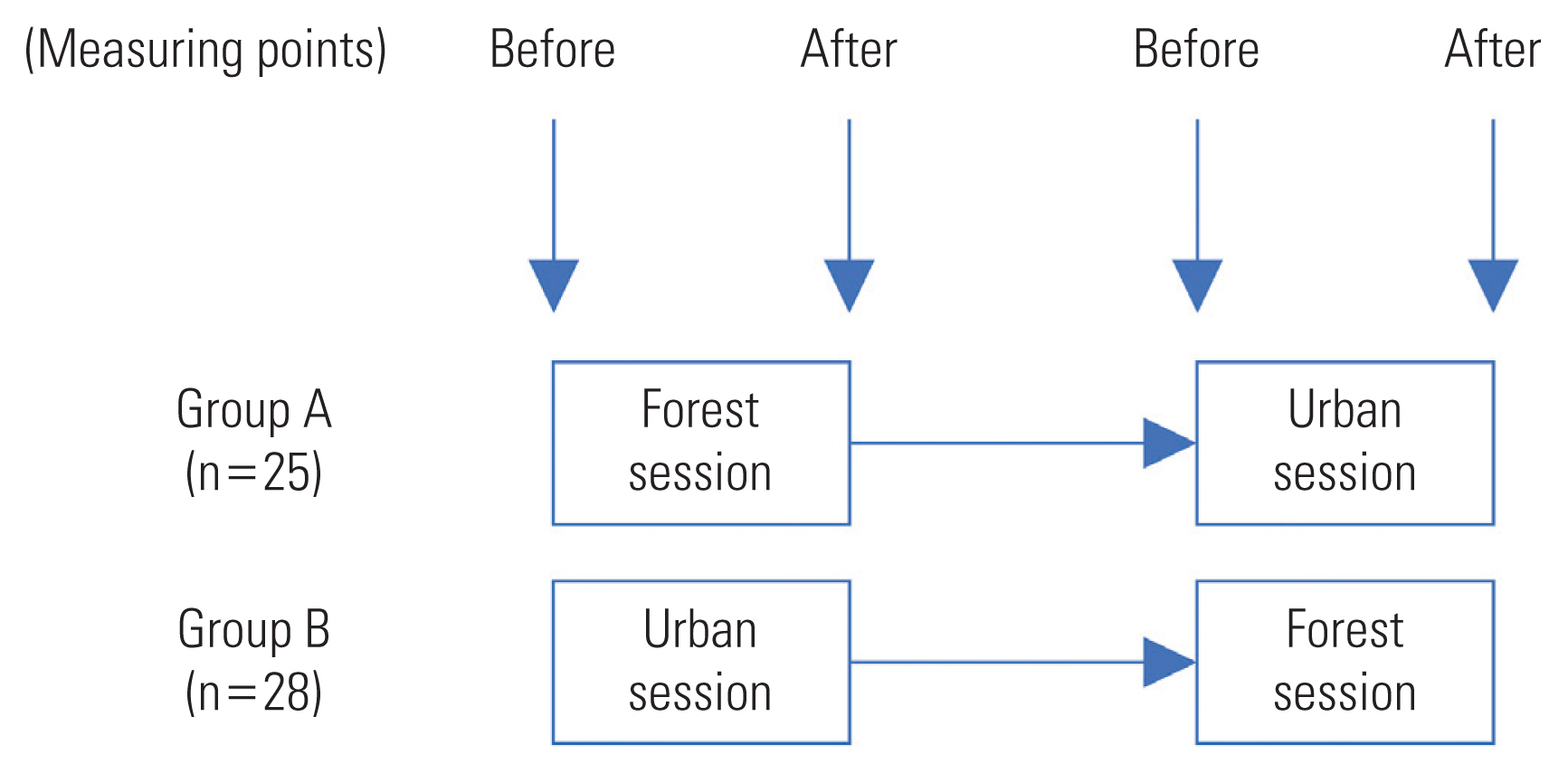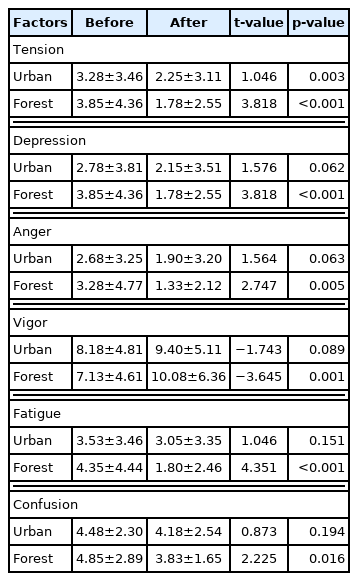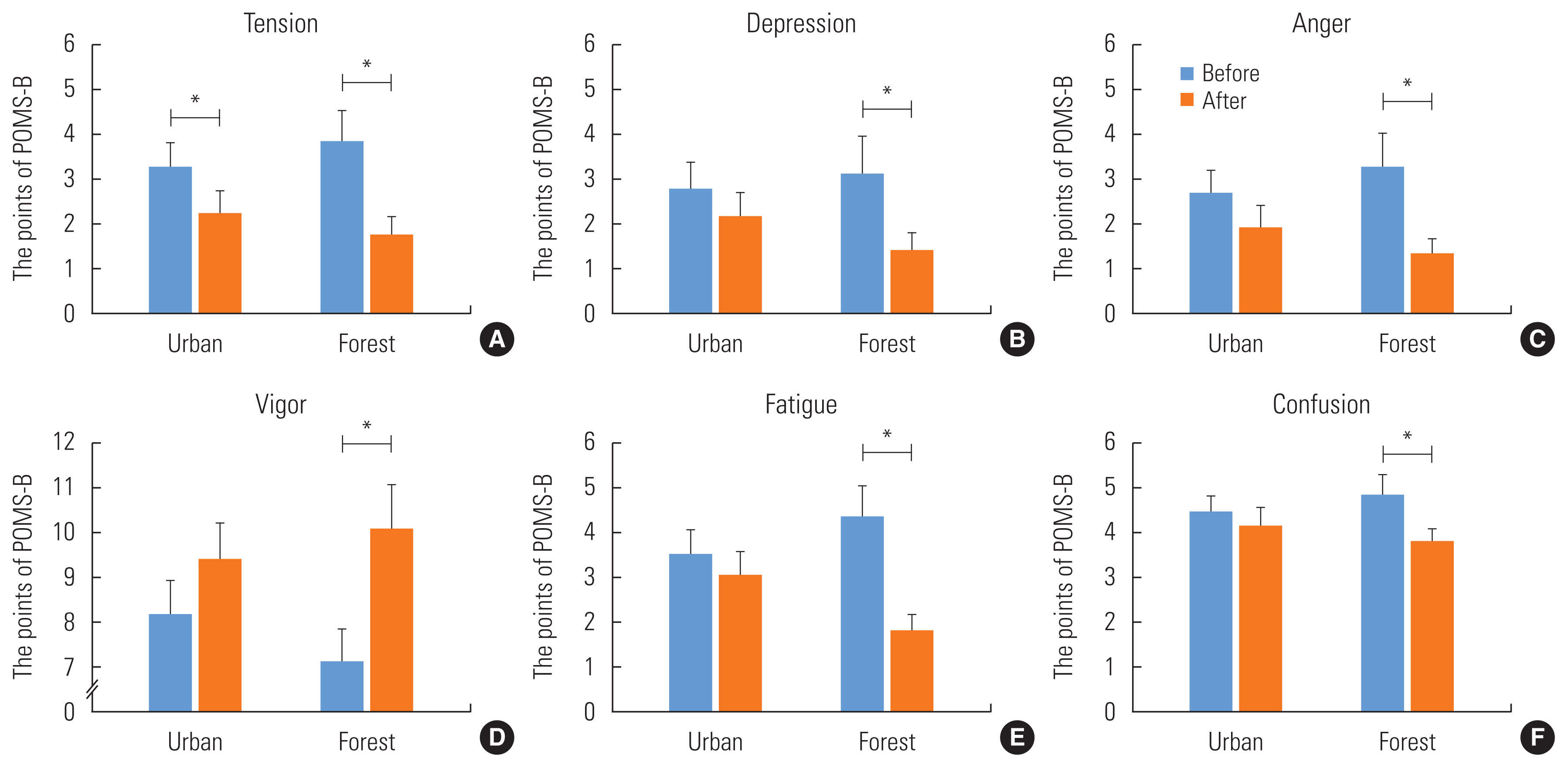Effects of Forest Therapy on Psychological Improvement in Middle-aged Women in Korea
Article information
Abstract
Objectives
Women experience more stress in middle age than in other periods of their lives. Therefore, health management programs that enable middle-aged women to cope with and manage stress are needed. This study investigated the psychological effects of a meditation-focused forest therapy program among 53 middle-aged women living in urban areas in Korea.
Methods
Participants were divided into 2 groups: one group underwent the program for 3 days in a forest, followed by 3 days in an urban environment, and the other group underwent the program for 3 days in the urban environment, followed by 3 days in the forest. The psychological effects of the forest therapy program were evaluated using the Profile of Mood States-Brief (POMS-B). Differences in mood state before and after the program conducted in the forest (experimental group) and in the urban environment (control group) were evaluated using the paired-samples t-test.
Results
The program in the forest significantly reduced tension, depression, anger, fatigue, and confusion among the domains of the POMS-B. The program in the urban area significantly reduced tension, but not depression, anger, fatigue, or confusion.
Conclusions
Meditation-focused forest therapy programs are expected to contribute to promoting psychological health and enhancing the quality of life of middle-aged women.
INTRODUCTION
Women spend half of their life in middle age and afterward, and stress management in middle age is becoming increasingly important for enjoying a healthy life in old age [1]. The common types of stress management programs that are currently being used can be summarized as follows: first, cognitive behavioral therapy aimed at changing ways of thinking or behaving; second, physical therapy, such as yoga, massage, and exercise; and third, meditation therapy that can induce concentration and insight [2]. Some stress management programs are conducted in nature. In particular, there is an increasing interest in forests as places to relieve stress [3], and programs aimed at relieving stress in forests are attracting at-tention from the perspective of preventive medicine [4].
Forest therapy refers to activities that use various environmental factors of forests to improve human health. Forests have environmental elements that make humans feel comfortable, such as beautiful scenery, clean air, sunlight, sound, phytoncides, and negative ions.
A forest therapy program uses forest-specific healing factors to maximize the healing effects of forests [5]. Six types of therapies are used for forest therapy programs: plant therapy, water therapy, diet therapy, psychotherapy, weather therapy, and exercise therapy [6]. Meditation in forest therapy programs aimed at managing stress is well regarded as a type of psychotherapy. Meditation can be actively used in forest therapy because a forest, where individuals can focus on the sounds of water, wind, and birds, and experience things through the 5 senses, is a good environment for meditation.
Several studies have investigated forests as places of healing that can improve health and prevent diseases. Increasingly many people are pursuing nature-based activities to reduce stress [7], and it is known that healing activities in forests help prevent and alleviate the symptoms of stress-related diseases [8].
Contact with natural environments increases resilience from stress, and is more effective in the rehabilitation of individuals in deep crisis than in those at lower levels of crisis [9].
A study indicated that a higher greenness index, which is the ratio of plant leaves within eyesight, was associated with better recovery from stress [10]. This suggests that seeing the color of the forest itself can help individuals recover from negative responses to stress. A recent review on meditation-focused forest therapy showed that previous studies were generally conducted among relatively young adults. Therefore, studies on more diverse populations will be informative [11].
This study aimed to investigate the psychological effects of a meditation-focused forest therapy program in middle-aged women (aged 40–65 years). To verify the effects of the forest therapy program in this study, the Profile of Mood States-Brief (POMS-B) was administered before and after the program and compared. The forest therapy program was conducted in a forest and in an urban environment, and the results were compared between these 2 settings.
METHODS
Participants
The participants in this study were middle-aged women (aged 40–65 years) living in urban areas. Women who were pregnant, were smokers, had hypertension, had received treatment at a hospital in the last 3 months, had circulatory disorders, or had allergic diseases were excluded. The selected 53 participants were divided into 2 groups. The number of participants in group A (forest-urban) was 25, and that in group B (urban-forest) was 28.
From October 10 to October 15, 2017, one group participated in the program for 3 days in a forest, followed by 3 days in an urban environment, and the other group participated in the program for 3 days in the urban environment, followed by 3 days in the forest.
Study Sites
Forest site
The forest site used in this study was a private healing forest located in Seomyeon, Hongcheon-gun, Gangwon-do, Korea. This healing forest site is located in a mid-mountainous area at an altitude of 250–580 m above sea level, and has an area of approximately 747 800 m2.
The forest tree species comprise Quercus variabilis (53%), Quercus mongolica (15%), Larix kaempferi (9%), Korean pine (8%), Quercus mongolica and Korean pine (7%), Quercus variabilis and Korean pine (4%), Quercus serrata and Korean pine (2%), and Quercus variabilis and Pinus rigida (1%), and the amount of water in the forest’s water system is abundant. There are 10 walking trails and trekking courses built on gentle slopes. Areas with a degree of green naturality of grade 7 or higher account for approx imately 80% of the forest.
Urban site
The urban site in this study was Wonkwang Digital University campus located in Daerim-dong, Yeongdeungpo-gu, Seoul, Korea. There is no forest within a radius of 1 km of the urban site; there are trees only on the sidewalk next to the road. The street trees consist of ginkgo trees.
Instruments
The psychological effects of the forest therapy program were measured using the Korean POMS-B that Yeun and Shin-Park [12] translated from the POMS-B developed by McNair et al. [13]. This tool consists of 6 domains: tension (5 items), depression (5 items), anger (5 items), vigor (5 items), fatigue (5 items), and confusion (5 items), totaling 30 items. Each item is rated on a 5-point scale, ranging from “strongly disagree” (0 points) to “strongly agree” (4 points). To minimize the influence of external variables that might affect the measurement results, each measurement was conducted during the same time slots. The internal reliability of the Korean POMS-B in this study was 0.93.
Program Composition and Procedure
The forest therapy program developed in this study was focused on meditation while listening to the sounds of the wind, water, and birds. The duration of the program was 3 days.
On the first day, an orientation to the program was provided. The participants completed the consent form and questionnaires, and pre-program psychological measurements were conducted. Subsequently, lying-down meditation and Zen yoga were conducted. Lying-down meditation is a relaxation meditation in which an individual lies down and relaxes his or her whole body to take a deep rest. In the Zen yoga class, the participants performed joint relaxation using yoga movements that can be easily performed by beginners.
On the second day, the participants went for a walk in the forest, and performed lying-down meditation, a healing touch exercise, and stress relief meditation. Before taking the walk in the forest, the participants were instructed to stretch their body, feel their breath, and calm their mind. For the healing touch exercise, they were instructed to pair up and give a massage to their partner to relieve their muscle tension and promote blood circulation. Then, they performed lying-down meditation and stress relief meditation. Stress relief meditation is a type of meditation that trains an individual’s mind to effectively cope with stress.
On the third day, they performed nature meditation, which is a type of meditation that restores one’s 5 senses and allows individuals to take a break by becoming aware of their inside and outside. After completing the day’s schedule, they completed the questionnaires and underwent post-program psy-chological measurements.
The POMS measurements were performed before and after the forest and urban area programs were conducted, respectively, as shown in Figure 1. In addition, there was no rest period between the forest session and the urban session. A rest period was not set because the carryover effect of forest healing was not expected to be long based on previous studies [14]. The experiment was conducted using a 2-period crossover design to eliminate any possible carryover effect.
Statistical Analysis
Data analysis was performed using SPSS version 21.0 (IBM Corp., Armonk, NY, USA). The demographic characteristics of the participants were analyzed using frequency analysis. Differences in POMS-B scores before and after the forest therapy program were evaluated using the paired t-test. The statistical significance level was set at p-value <0.05.
Ethics Statement
The study was conducted in accordance with the Declaration of Helsinki, and the protocol was approved by the Institutional Review Board of Chungnam National University (201708-SB-020-01).
RESULTS
General Characteristics of the Participants
Frequency analysis of the participants’ general characteristics was performed, including age, education level, residential area, household income, and occupation (Supplemental Material 1).
Psychological Effects of Forest Therapy
Changes in tension, depression, anger, vigor, fatigue, and confusion after the forest therapy program were analyzed using the paired samples t-test. The program in the forest significantly reduced tension, depression, anger, fatigue, and confusion, and increased vigor among the domains of the POMS-B. In contrast, the program in the urban area significantly reduced tension, but not depression, anger, fatigue, or confusion, and did not increase vigor (Table 1 and Figure 2).
DISCUSSION
The results of this study are consistent with previous studies indicating that negative emotions such as tension, depression, anger, fatigue, and confusion decreased after forest therapy, whereas positive emotions such as vigor increased [15]. Studies have reported that negative emotions, such as anxiety, depression, anger, fatigue, and confusion decreased in those who participated in a forest experience program [16]. Furthermore, contact with nature is effective in alleviating depression [17].
A study that investigated the effects of forest therapy using psychological indicators showed that a forest therapy program spanning 3 days and 2 nights reduced depression and anger and increased positive emotions in emotional workers [6]. Activities in forests have also been reported to induce psychological relaxation [18].
The forest therapy program administered in this study was focused on meditation. The forest therapy program was a combination of various factors and therapies, such as exercise, yoga, and meditation. Psychotherapy, 1 therapy of the 6 therapies used in the forest therapy program, mainly comprises meditation, which involves calming and concentrating one’s mind and is derived from the Latin meditatio, which means “to think deeply.” Therefore, meditation is a mental process of achieving self-transcendence and self-development through the concentration of consciousness [19]. Meditation serves to activate the limbic system, the part of the brain that is responsible for regulating emotions, thereby increasing the activity of the amygdala and hippocampus. Meditation in forests can be more effective than meditation indoors because the healing factors of forests facilitate meditation. Meditation in the forest is aimed at achieving awareness while observing the precious vitality of nature through encounters, communication, and contact with nature. In addition, mindfulness meditation has been proposed as a technique for forest healing. Mindfulness can have a healing effect by integrating the body and mind through attention training. Meditation in the forest is a way to actively use the healing factors of the forest [20].
Meanwhile, the results of this study showed that when the program was conducted in an urban environment, it reduced depression, anger, fatigue, and confusion, and increased vigor, but not to a statistically significant degree. Even though the program conducted in the urban environment had the same content as that in the forest, it had no significant effects on psychological factors, indicating that the urban environment was not appropriate for obtaining such effects.
This study demonstrated that a meditation-focused forest therapy program had stress reduction effects in healthy middle-aged women. However, a limitation of this study is that caution must be exercised when generalizing the present results because they were obtained in a short-term experiment. A rest period was not set between the 2 sessions. If there was a carryover effect of forest therapy, our results may have been underestimated. Further studies involving other age groups and participants are needed in the future. The results of this study can be used as basic data for the development of forest therapy programs.
The forest therapy program developed in this study was focused on meditation while listening to the sounds of the wind, water, and birds. The participants performed the 3 types of meditation—lying-down, stress relief, and nature meditation—every day for 3 days. The contribution of this study is that a meditation-focused forest therapy program led to psychological improvements in middle-aged women.
SUPPLEMENTAL MATERIALS
Supplemental material is available at https://doi.org/10.3961/jpmph.22.086.
Notes
CONFLICT OF INTEREST
The authors have no conflicts of interest associated with the material presented in this paper.
FUNDING
This research was funded by Seokchun Caritas Foundation (grant No. SF171).
ACKNOWLEDGEMENTS
The funders had no role in the design of the study; in the collection, analyses, or interpretation of data; in the writing of the manuscript, or in the decision to publish the results.
Notes
AUTHOR CONTRIBUTIONS
Conceptualization: Park BJ, Kim DJ, Kim YH, Park CE, Shin WS, Shin CS, Chung CY, Lee SH. Data curation: Kim YH, Park CE. Formal analysis: Park BJ, Kim DJ, Kim YH, Park CE. Funding acquisition: Park BJ. Methodology: Park BJ, Kim DJ, Kim YH, Park CE. Project administration: Park BJ, Kim YH, Park CE. Visualization: Kim YH, Park CE. Writing – original draft: Park BJ, Kim DJ, Kim YH, Park CE. Writing – review & editing: Park BJ, Yeon PS, Kim DJ, Kim YH, Park CE, Shin WS, Shin CS, Chung CY, Lee SH.



